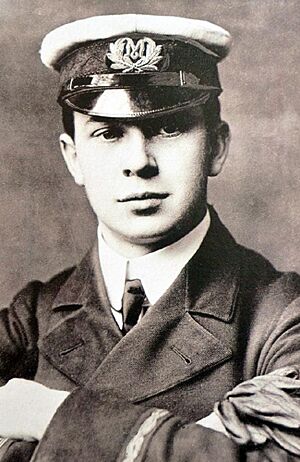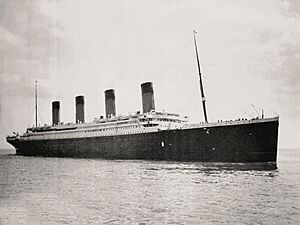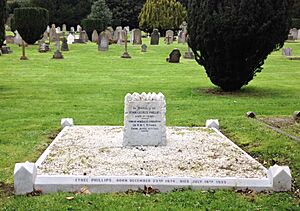Jack Phillips (wireless officer) facts for kids
Quick facts for kids
John Phillips
|
|
|---|---|

Phillips in 1912
|
|
| Born | 11 April 1887 Farncombe, Surrey, England
|
| Died | 15 April 1912 (aged 25) |
| Resting place | North Atlantic Ocean |
| Occupation | Wireless telegraphist |
| Employer | Marconi Company |
| Known for | Senior wireless operator aboard the RMS Titanic |
John George “Jack” Phillips (born April 11, 1887 – died April 15, 1912) was a British sailor. He was the main wireless (radio) operator on the famous ship Titanic. This was during its first trip in April 1912, which sadly ended when the ship sank.
On the night the Titanic sank, Phillips was very busy. He was sending many messages because the radio system had broken down earlier. He received an ice warning from another ship, the Mesaba. He knew about it but did not pass it to the ship's bridge. Another warning from the nearby Californian was also not fully handled. However, Phillips and his helper, Harold Bride, had already sent over twenty ice warnings to the bridge. After the Titanic hit an iceberg, Phillips worked hard to contact other ships for help. He died when the ship sank.
Contents
Early Life and Training
Phillips was born on April 11, 1887, in Farncombe, England. His father, George Alfred Phillips, was a shop manager. Jack lived with his family above his father's shop. He went to school and sang in the church choir.
After finishing school in 1902, Phillips started working at a post office. There, he learned how to use a telegraph. In 1906, he began training to work with wireless radio for the Marconi Company. He finished his training five months later.
Phillips worked on several ships for different companies. These included the Teutonic, Campania, and Lusitania. In 1908, he worked at a Marconi radio station in Ireland. He stayed there until 1911, before returning to work on ships like the Adriatic and Oceanic.
Working on the RMS Titanic
In March 1912, Phillips was chosen to be the senior wireless operator on the Titanic. He went to Belfast, Ireland, where the ship was built. Harold Bride joined him as the junior wireless operator. The Titanic began its first journey from Southampton, England, to New York City, United States, on April 10, 1912. During the trip, Phillips and Bride sent messages for passengers. They also received important iceberg warnings from other ships. Phillips turned 25 years old the day after the voyage started.
On the evening of April 14, Phillips was busy in the wireless room. He was sending many messages to Cape Race, Newfoundland. These were messages from passengers that had piled up because the radio had stopped working the day before. Bride, his helper, was asleep. He was planning to take over from Phillips at midnight.
Around 9:30 PM, Phillips received an ice warning from the ship Mesaba. It reported a lot of icebergs and an ice field right in the Titanic's path. Phillips confirmed he got the message. However, he kept sending messages to Cape Race. He did not pass this important warning to the ship's bridge. The Mesaba's operator waited for Phillips to confirm he had given the report to the bridge, but Phillips continued his work.
Another ship, the SS Californian, tried to contact Phillips at 10:55 PM. Cyril Evans, the Californian's radio operator, said they were stopped because they were surrounded by ice. Phillips quickly told him, "Keep out; shut up, I'm working Cape Race." He continued his work, and Evans soon turned off his radio for the night.
This moment was very important. The Californian was the closest ship to the Titanic. Because Evans turned off his radio, Phillips could not contact them when the Titanic soon needed help. However, some people say that the Titanic captain already knew about ice in the area from other warnings. Also, the Californian crew saw rockets from the Titanic later but did not act.
The Titanic hit an iceberg at 11:40 PM that night and began to sink. Bride woke up and was getting ready to take over from Phillips. Captain Edward Smith came into the wireless room. He told Phillips to get ready to send a distress signal. Soon after midnight, Captain Smith returned. He told them to send a call for help and gave them the Titanic's location.
Phillips began sending the distress signal, which was the code CQD. Bride took messages to Captain Smith about which ships were coming to help. At one point, Bride joked with Phillips. He reminded him that the new distress call was SOS. He said, "Send S.O.S., it's the new call, and it may be your last chance to send it." Phillips successfully contacted the RMS Carpathia, which immediately headed towards the Titanic.
After a short break, Phillips went back to the wireless room. He told Bride that the front part of the ship was filling with water. He said they should put on more clothes and lifebelts. Bride started to get ready, while Phillips continued working on the radio.
The radio power was almost gone after 2:00 AM. Captain Smith came in and told the men they had done their job and could leave. Bride later remembered how Phillips kept working, even as the ship was sinking. As they turned away, a crew member tried to steal Phillips's lifebelt. Bride got angry and fought the man. Water was flooding the wireless room as they both ran out. They left the crewman behind. The men then went in different directions. Bride went towards the front of the ship, and Phillips went towards the back. This was the last time Bride saw Phillips.
What Happened to Phillips
It is not fully clear what happened to Jack Phillips. Some stories say he made it to an overturned lifeboat called Collapsible B. This boat was led by Second Officer Charles Lightoller. In an interview, Bride said that a man from boat B had died, and he thought it was Phillips when he saw a body on the Carpathia. However, Bride later changed his story. He said he was only told that Phillips died on Collapsible B.
Other people, like Colonel Archibald Gracie, said the body taken from the boat was not Phillips. Lightoller also changed his story over time. In his later book, he wrote that Phillips was on Collapsible B and told everyone where rescue ships were. He said Phillips then died from the cold. But Lightoller's earlier statements from 1912 do not match this. It seems that the person calling out ship names on the overturned boat was actually Harold Bride, not Jack Phillips.
It is possible that Phillips's body was never found or identified.
Remembering Jack Phillips

There are memorials to Jack Phillips in Farncombe and Godalming, England. One is at Nightingale Cemetery. Another is the Phillips Memorial Cloister, a special building in Godalming.
In 2012, on the 100th anniversary of the disaster, a radio show called Titanic – In Her Own Words was broadcast. It used computer voices to sound like the original Morse code messages from the Titanic and other ships. These messages often used slang from that time. The BBC noted that these messages were written down by hand and are now kept in different collections around the world.
Portrayals in Movies
Jack Phillips has been shown in several movies and TV shows about the Titanic:
- Kenneth Griffith (1958) in A Night to Remember
- Matt Hill (1996) in Titanic (TV miniseries)
- Gregory Cooke (1997) in Titanic
- Mark James Fernandes (2006) in Seconds from Disaster
- Thomas Lynskey (2012) in The Last Signals
See Also
- Titanic navigation bridge



